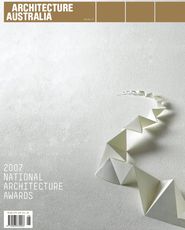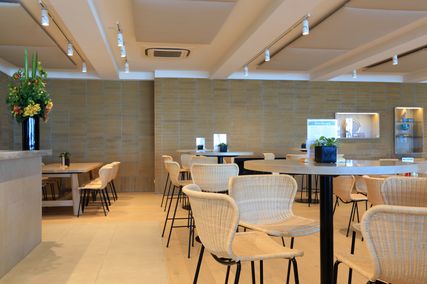The three weeks the national jury spends deliberating and flying around the country, looking at the best of Australian architecture, bring into focus the many contemporary challenges facing Australian architects. This jury review aims to capture something of the process and the themes of the deliberations in 2007. This year the jury was comprised of practitioners, practitioner-academics and academic-practitioners, architects interested in the discourse of ideas and how they might find their way into contemporary practice. The jury deliberations were highly, even exhaustingly, discursive – and the final decisions are, in a sense, the end point of this dialogue and conjecture and, ultimately, a form of consensus. The jury hopes that this diversity of opinion in some way connects with the diversity of architecture being practised across the nation.
Although the jury carried its formal terms of reference and official evaluation criteria in its hip pocket, it was also looking for something else. In particular we found ourselves looking to projects that exceeded a well-executed professional commission, ones that demonstrated an architectural intelligence regarding either its category type or wider concerns that transcended the baseline criteria – those projects with intelligent, even ambitious, ideas which also parlay into exemplary architecture.
As an example, this year saw the introduction of two new categories, Multiple Housing and Small Project. Multiple Housing recognizes the critical importance of this area, as Australian cities enlarge and become denser, in creating a smaller, more sustainable “footprint”, and also in response to the need for new models for housing affordability. The clear challenge for architects and the development community (particularly in an era where direct government investment in housing models is extraordinarily low) is to create new models to which consumers can subscribe, which are also of sufficient quality to create a lasting change in the way our society views these models – not as a poor substitute for the traditional suburban dwelling, but as a viable alternative.
The category of Small Project Architecture demonstrates how small interventions can have a large effect on the built environment. Small projects have traditionally been disadvantaged in the awards when compared to the scale and budgets of other works. The jury cast a wide net on the idea of “small” – physically small, small practices, and small programmes – and was impressed by the largeness and inventiveness of the thinking in many projects. This award holds promise to evolve as a register of future practice, in which successful small projects develop into larger contributions.
For the categories which already have a clear historical record, the impetus was somewhat different. In the Houses category, the singular dwelling continues to be central to architects’ professional design research, and is also the arena of greatest interest to the broader community. Ironically, it may also be seen as an area of diminishing influence as new affordable housing models are actively sought. So the jury was impressed with projects that pointed housing in new directions – that explored how to keep the model viable in our increasingly urbanized culture, or how to make viable sustainable models for our local ecologies. For Public Architecture, the projects suggested a similar growing confidence in the role and value of architecture in the public realm, adding to the livability of our cities and regions – even a modest sense of nation building.
In Interior Architecture, the awarded projects suggest ways that interiors can work successfully, either at the scale of the urban realm or by creating spaces of private and personal intimacy.
Within the Heritage category, traditional conservation projects were considered alongside the contemporary need to adapt and reuse buildings that were integral to the needs of the city of the industrial revolution, but need ongoing relevance and connection to a city shaped by the knowledge economy. Sustainability was a theme across all the categories, and has quickly become embedded in the core practice of architecture, with its rapid “mainstreaming”. The jury considers that the separate category for sustainability may have built-in obsolescence – which, paradoxically, represents a kind of victory.
The International category, now in its second year, included a large number of entries from both offshore member practices and those exporting their services. This category is a guide to Australian architects’ position within the global marketplace, and many of these projects spoke to the themes of the global design economy, particularly on how to be culturally relevant in the process of exporting ideas to a “host” country – ideas which allow projects to transcend the international and the generic.
Perhaps the final question is, what do the award winners say about the state of Australian architecture in 2007? It is, of course, not possible to expect the spread of winners to weave a definitive narrative on this larger theme, but each in their own exemplary way pushes at the boundary of what is important to the places in which we live, think, work and play. The jury was particularly struck by architects around the country increasingly undertaking design research, especially on the issues of urbanization and its counterpoint of sustainability.
The success of this approach seems to come from a wider dialogue between the academies and leadership practices, as well as with government and the development industry – a dialogue about a shared vision for the local condition. This is particularly relevant when the architecture profession is operating in a boom economy. This boom is creating a substantial market for ideas, yet almost perversely is also putting negative pressure on the quality of outcomes. Issues such as government and private funding, forms of procurement (such as novation), and risk allocations all press against the success of the outcomes. This is perhaps the cautionary tale of 2007.
Finally, I would like to thank my fellow jurors – Professor Tom Heneghan, John Wardle, Professor Brit Andresen and Gerard Reinmuth – for their contribution to the judging process, and for bringing their own intelligence and candour to the discussions. I’d particularly like to thank Tom Heneghan, who, as Deputy Chair, led this year’s review and assessment in the Public and Sustainable Architecture categories.
Carey Lyon, 2007 RAIA National Jury chair
Jury
Carey Lyon (chair), Tom Heneghan, Brit Andresen, John Wardle, Gerard Reinmuth















